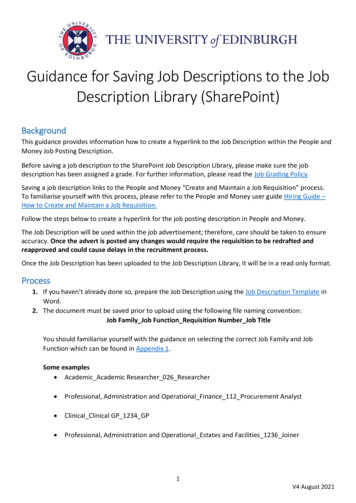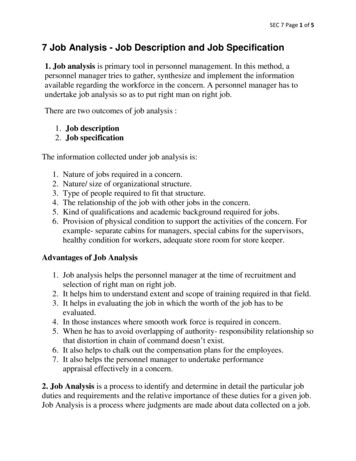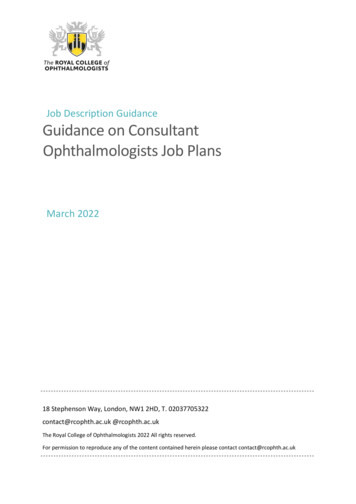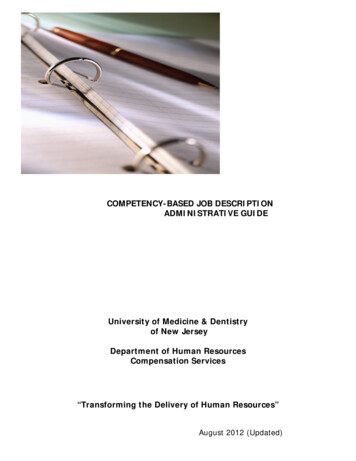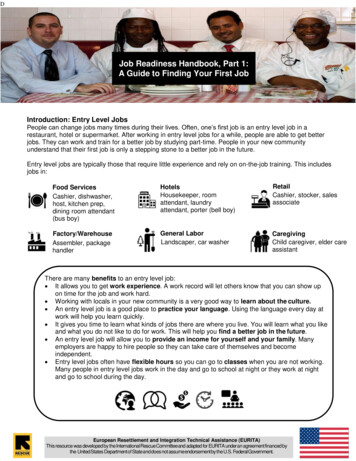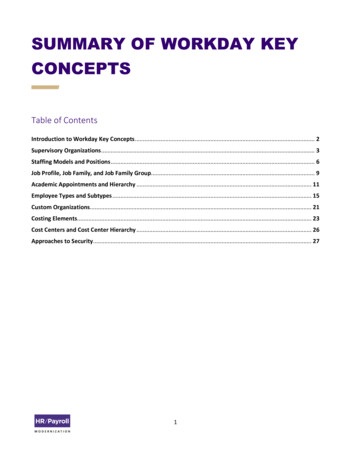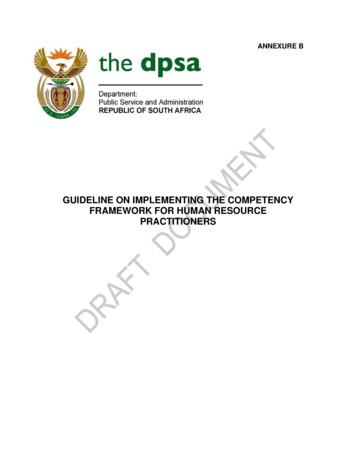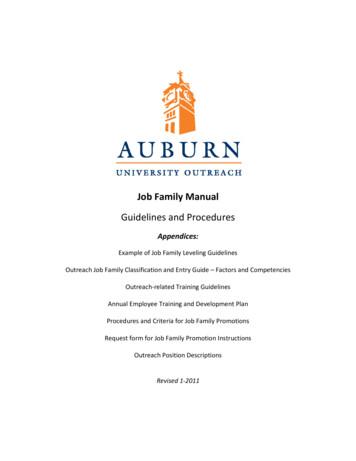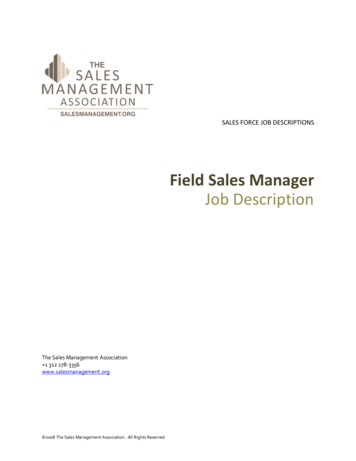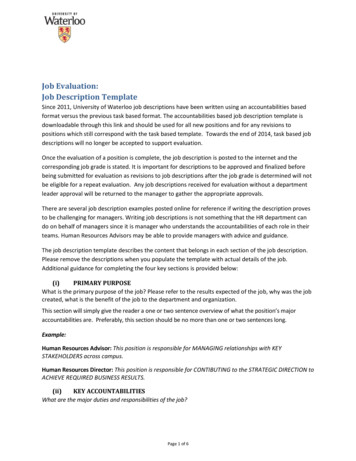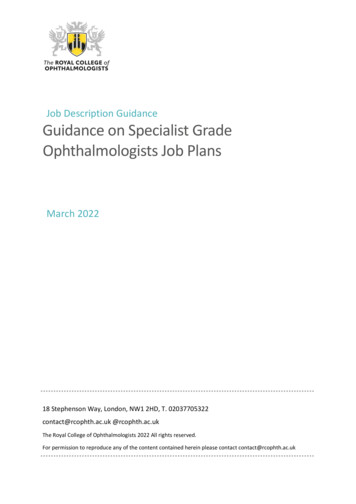
Transcription
Job Description GuidanceGuidance on Specialist GradeOphthalmologists Job PlansMarch 202218 Stephenson Way, London, NW1 2HD, T. 02037705322contact@rcophth.ac.uk @rcophth.ac.ukThe Royal College of Ophthalmologists 2022 All rights reserved.For permission to reproduce any of the content contained herein please contact contact@rcophth.ac.uk
ContentsSection1. IntroductionBackground3. Job descriptionInformation on the employing organisationThe postMedical audit and CPDRevalidationWorkload figuresTime off in lieuMentoringFlexible working4. Job plansWorking weekProgrammed activityPremium timeTimetableDirect clinical care (DCC)Additional NHS ResponsibilitiesExternal dutiesOn-call dutiesAdditional programmed activities5. Person specificationEntry criteria to the specialist doctor gradeProfessional values and behaviours, skills and knowledgeLeadership and teamworkingPatient safety and quality improvementSafeguarding and vulnerable groupsEducation and trainingResearch and scholarship6. Specialist grade - template person c 17. Generic Capabilities Framework12Appendix 1: Process for Associate Specialists transferring to Specialist contract (FromNational Framework Document)20Date of review: October 20232022/PROF/4522
1. IntroductionThis guide explains the RCOphth’s guidance and requirements for approving and job plansfor NHS Specialist Grade ophthalmologist posts. It does not cover Medical Ophthalmologyposts which should be sent to The Royal College of Physicians (RCP).Council Regional Representatives (RRs) will use this guidance when reviewing jobdescriptions against national standards and criteria; to consider whether the post representsa satisfactory consultant post within the local circumstances of the trust* and in line withrelevant terms and conditions of service.RCOphth approval of job descriptions should be obtained prior to advertising the post.The new Specialist Grade was introduced from 1st April 2021.The term 'SAS doctor' includes specialty doctors and specialist grade doctors with at leastfour years of postgraduate training, two of which are in a relevant specialty.SAS doctors are a diverse group with a wide range of skills, experience and specialties. Theyare an essential part of the medical workforce. The Specialist Grade sits between theSpecialty Doctor and Consultant grades.The main difference between the Specialty Doctor and Specialist Grade is that the new rolewill provide a greater amount of expertise, responsibility, decision-making and competence.A Specialist Grade doctor will be responsible for the patients under their care and havegreater opportunity to undertake wider professional activities and additional NHSresponsibilities such as management roles.The three key differences between the Specialist Grade role and Consultant roles are: A Specialist Grade will be an expert in a narrower field and will workindependently in their defined area of practice (as agreed locally) whereas aConsultant has more breadth of expertise in their entire specialty and isindependent within that broader role and; Consultants are expected to carry out a variety of wider responsibilities includingmanagerial and leadership roles that incorporate teaching, training, audit,research, for example. A Specialist Grade doctor will have the opportunity tocarry out wider roles and will be encouraged to do so, however there will be noexpectation of this. Consultants are required to be on the specialist register (possess CCT or CESR)The introduction of this role will follow one of three scenarios:1. Doctor is already on national Associate Specialist terms and conditions of service andis eligible for assessment to transfer to the new role with back pay to 1st April 2021, ifsuccessful.2. Appointment to a Specialist grade post through competitive recruitment to a newpost.3. Appointment to a Specialist grade post through internal recruitment to a new postwhere external recruitment would place a Trust employed doctor “at risk”.2022/PROF/4523
BackgroundThe concordat between the Academy of Medical Royal Colleges and NHS Employers on theappointment of specialist medical staff states Employers will use the generic capabilities framework and template personspecification, which they will develop based on the requirements of the service. Where the clinical lead judges that further input is required, the employer willwork with the RCOphth’s regional representative in developing personspecifications and reviewing the curricula to clarify any specialty-specificcapabilities that may be required and the evidence to help meet these. Wherethere is an accepted national standard or statutory requirement for a specialtyspecific competence illustrative examples will be recognised by the relevantcurriculum. It will be for employers to determine locally what specific entry criteria they arelooking for in the person specification which will be relevant to the individualpost. The employer will inform RCOphth of their intention to proceed with recruitmentonce the person specification for the post has been approved by the employer.The approved person specification will be shared with RCOphth. An RCOphth representative will be invited to attend the interview.The RCOphth’s role is limited by concordat to giving advice on the person specificationand providing a representative for interview. However, the RCOphth can only give adviceon the person specification if the role (job plan) and supporting environment (jobdescription) are made available. The RCOphth’s role is to provide advice and its views maysometimes differ from those of the employing organisation, but discussion should enablea mutually satisfactory agreement, facilitating the employer to make a good appointment.3.Job descriptionA job description should include:Information on the employing organisationKey servicesCatchment area and populationRegional and national servicesUniversity links, support and resources for researchDevelopment plansManagement Structureo Tertiary centre, teaching hospital or DGHo On-site serviceso Relationship with other hospitalso Development plan The Department Management structureo Work of the departmento Location/s care is delivered in and where the post holder will work 2022/PROF/4524
o Numbers and composition of medical staff: (consultants, trainees,specialty doctors) it should be clear what staff will be available tosupport the appointee and these should be defined.o Support staff: (orthoptists, optometrists, medical photographers,technicians)o Relationship with other departmentso Clinical activity - contracts e.g. outpatient attendance figureso Facilities available: inpatient (number of beds), day case, theatres,outpatient (general and special interest), accident and emergency,diagnostic facilities Secretarial/IT/office facilities - a commitment to defined secretarial support andan adequately equipped office, including defined availability of informationtechnology (IT) facilities. If there is lack of support then additional PAs will berequired for patient administration.The post Job title, whether whole or part-time and employing authority. The main duties and responsibilities of the post, including information on theclinical, teaching, research and administrative elements. Where a sub-specialty is specified the equipment and infrastructure relevant tothat specialty should be indicated Clinical director/manager to whom responsible; names and grades of othermembers of staff. Details of all clinical commitments including fixed sessions, supportingprofessional activities and duties at other establishments. Details of out-of-hours and unsocial hours responsibilities, including rotacommitments, where appropriate. Timetable. Details of any other duties including the supervision and support of other staff,teaching, administrative and research requirements or opportunities. Theprovision to offer a named mentor to new consultants on appointment. Requirements to participate in audit and clinical governance under localarrangements. Management responsibilities.Medical audit and CPD a statement on expectations regarding medical audit a statement on expectations for continuing professional development (CPD). Asuitable form of wording is: ‘The trust supports the requirements for continuingprofessional development (CPD) as laid down by the Royal College ofOphthalmologists and is committed to providing time and financial support forthese activities.’RevalidationThe trust should ensure it has the required arrangements in place for appraisal as laid downby the RCOphth, to ensure that all doctors have an annual appraisal with a choice of trainedappraiser and are supported when going through the revalidation process.2022/PROF/4525
Workload figuresPotential appointees like to have some idea of the inpatient and outpatient workload (newand follow-up) of the department that they will be joining, and the expectations of thepersonal workload for the job. Emergency cover arrangements/policies should be included.Time off in lieuThere are concerns about doctors not being allowed time off in lieu (such as for weekendworking), and the Trust should address rest requirements, particularly for new specialistdoctors.MentoringThe job description should always include a reference to information about access tomentoring for newly appointed specialist doctor. The RCOphth believes that every newlyappointed specialist doctor should be offered opportunities for development to aidtransition into their new role. These opportunities should include mentoring (departmental,trust or external), leadership development (through teaching/training supported by practicalopportunities), networking, education and personal wellbeing. The RCOph is not prescriptiveas to how the hospital or trust does this, as it may vary by trust or specialty. Thedevelopment arrangements for the person who is recommended for appointment at theAdvisory Appointments Committee (AAC) should be discussed and agreed by the AAC aspart of its decision-making process.Flexible workingIt is desirable to have a statement in the job description and advert that says how thattrust/department embraces flexible working. The job should be advertised as available tofulltime (FT)/less than fulltime (LTFT) applicants. In the construction of the job description,consideration should be made as to the key core elements of the job, and therefore how thejob could be adapted for someone who wishes to work LTFT or flexibly. All job advertsshould then state that applications are welcome from individuals who wish to workLTFT/flexibly.4. Job plansIn considering job planning regional advisers should refer to the publication Terms andConditions of Service Specialist April 2021. The job plan of a Specialist doctor should ideallymirror that of a consultant.Working weekA standard full-time working week based on a job plan containing ten programmedactivities.Programmed activityProgrammed activity (PA) means a scheduled period, normally equivalent to four hours(which may be equated to three hours in premium time), during which a doctor undertakescontractual and consequential services.2022/PROF/4526
Premium timeAny programmed activity undertaken outside of the hours 7am to 9pm, Monday to Friday,and all of Saturday and Sunday, and any statutory or public holiday, is regarded as takingplace in ‘premium time’. This means that a programmed activity at these times lasts onlythree hours instead of four hours.TimetableThe timetable should provide sufficient breadth and depth of clinical work and relevantprofessional activities to enable the specialist doctor to achieve and maintain relevantcompetencies and develop as a clinician.There should be a sample weekly timetable that takes account of the programmed activitiesoutlined below and is broken down into AM and PM sessions with timings.Direct clinical care (DCC)DCC is work that directly relates to the prevention, diagnosis or treatment of illness. PAs dedicated to direct clinical care should be stated. PAs dedicated to dictating letters, reviewing results, attending multidisciplinaryteam meetings and case presentations, and seeing relatives should be stated. Every 1PA DCC clinic generally requires 0.25PA of patient-related administrationas part of the DCC, although complex clinics may require more. All non-face-to-face patient care may be included under virtual clinical activity(where a face-to-face consultation is replaced with communication via letter ortelephone (e.g., to give results, diagnosis, medication changes, answer patientqueries etc) in job plans, rather than under administrative time. Non-face-to-faceclinical activity also includes telemedicine clinics, telemedicine triage andelectronic Advice and Guidance.SPAs are activities that underpin DCC. A minimum of 1.5 SPAs is included for revalidation only (a minimum of 1 if thepost is less than 10 PAs). This includes audit, CPD, and appraisal. The terms andconditions of the specialist doctor contract state there should be a minimum of 1SPA for full time doctors. The minimum requirement for revalidation is at least1.5 SPA and therefore the RCOphth will not approve full time specialist doctorpost which has less than 1.5 SPA. Good practice guidance In Wales advocates20% of time for SPAs for all SAS doctors. Additional SPAs have been allocated such as for teaching, research, assessmentof trainees, clinical governance and service development. Jobs with 1.5 SPAs are clinical only, with no commitment to teaching, research,assessment of trainees, clinical governance and service development and are nottypically appropriate to specialist doctor level appointment.Additional NHS ResponsibilitiesAdditional NHS Responsibilities are special responsibilities within the employing organisationnot undertaken by the generality of doctors, which are agreed between the doctor and theemployer and which cannot be absorbed in the time set aside for supporting professionalactivities. These could include, for example being a clinical manager, clinical governance leador clinical audit lead.2022/PROF/4527
External dutiesExternal duties are work that not included in the definitions of ‘Direct Clinical Care’,‘Supporting Professional Activities’ and ‘Additional NHS Responsibilities’, and not includedwithin the definition of Fee Paying Services or Private Professional Services. They areundertaken as part of the prospectively agreed job plan by agreement between the doctorand the employing organisation without causing undue loss of clinical time. They mightinclude, for example, trade union duties, reasonable amount of work for the Royal Collegesor Government Departments in the interests of the wider NHS.On-call dutiesThe frequency of on-call commitments should be clearly stated. Compensatory rest shouldbe accommodated within the job plan. It would be helpful to include information on thenumber of patients that a specialist doctor should expect to see and information on thetimes they should expect to be in the hospital.Additional programmed activitiesThe terms and conditions provide flexibility for employers and specialist doctor to agree tocontract for additional PAs for a variety of purposes, although a specialist doctor cannot becompelled to agree to a contract containing more than ten PAs.5. Person specificationThere should be a person specification detailing the essential and desirable qualifications,skills and experience required to perform the job.Entry criteria to the specialist doctor gradeA doctor appointed to this grade shall have Full registration with the General Medical Council and Completed a minimum of 12 years medical work (either continuous period or inaggregate) since obtaining a primary medical qualification, of which a minimumof 6 years should have been in a relevant specialty Meets the criteria set out in the generic capabilities framework for the specialistgrade which has been developed by AoMRC, BMA and NHS Employers.Professional values and behaviours, skills and knowledge1.11.21.31.4Practises with the professional values and behaviours expected of all doctors as setout in GMC Good Medical Practice and the Generic Professional CapabilitiesFramework [or equivalent for dentists].Demonstrates the underpinning subject-specific competencies i.e. knowledge,skills and behaviours relevant to the role setting and scope.Clinically evaluates and manages a patient, formulating a prioritised differentialdiagnosis, initiating an appropriate management plan, and reviewing and adjustingthis depending on the outcomes of treatment.Manages the difficulties of dealing with complexity and uncertainty in the care ofpatients; employing expertise and clinical decision-making skills of a senior and2022/PROF/4528
independent/ autonomous practitioner. [All senior doctors/dentists [includingconsultants and GPs] work independently/ autonomously to a level of definedcompetencies, as agreed within local clinical governance frameworks.]1.5 Critically reflects on own competence, understands own limits, and seeks helpwhen required.1.6 Communicates effectively and is able to share decision-making with patients,relatives and carers; treats patients as individuals, promoting a person-centredapproach to their care, including self-management.1.7 Respects patients· dignity, ensures confidentiality and appropriate communicationwhere potentially difficult or where barriers exist, e.g. using interpreters andmaking adjustments for patients with communication difficulties.1.8 Demonstrates key generic clinical skills around the areas of consent; ensuringhumane interventions, prescribing medicines safely and using medical devicessafely.1.9 Adheres to professional requirements, participating in annual appraisal, jobplanning and reviews of performance and progression.1.10 Awareness of legal responsibilities relevant to the role, such as around mentalcapacity and deprivation of liberty; data protection; equality and diversity.1.11 Applies basic principles of public health; including population health, promotinghealth and wellbeing, work, nutrition, exercise, vaccination and illness prevention,as relevant to their specialty.Leadership and teamworking2.12.22.32.42.52.62.7Awareness of their leadership responsibilities as a clinician and demonstratesappropriate leadership behaviour; managing situations that are unfamiliar,complex or unpredictable and seeking to build collaboration with, and confidencein, others.Demonstrates understanding of a range of leadership principles, approaches andtechniques so can adapt leadership behaviours to improve engagement andoutcomes - appreciates own leadership style and its impact on others.Develops effective relationships across teams and contributes to work and successof these teams - promotes and participates in both multidisciplinary andinterprofessional team working.Critically reflects on decision-making processes and explains those decisions toothers in an honest and transparent way.Critically appraises performance of self, colleagues or peers and systems toenhance performance and support development.Demonstrates ability to challenge others, escalating concerns when necessary.Develops practice in response to changing population health need, engaging inhorizon scanning for future developments.Patient safety and quality improvement3.13.23.33.4Takes prompt action where there is an issue with the safety or quality of patient care,raises and escalates concerns, through clinical governance systems, where necessary.Applies basic human factors principles and practice at individual, team,organisation and system levels.Collaborates with multidisciplinary and interprofessional teams to manage riskand issues across organisations and settings, with respect for and recognitionof the roles of other health professionals.Advocates for, and contributes to, organisational learning.2022/PROF/4529
3.5Seeks feedback and involvement from individuals, families, carers, communitiesand colleagues in safety and quality service improvements reviews.3.6 Leads new practice and service redesign in response to feedback, evaluation andneed, promoting best practice.3.7 Evaluates and audits own and others· clinical practice and acts on the findings.3.8 Reflects on personal behaviour and practice, responding to learning opportunities.3.9 Implements quality improvement methods and repeats quality improvementcycles to refine practice; designing projects and evaluating their impact.3.10 Critically appraises and synthesises the outcomes of audit, inquiries, criticalincidents or complaints and implements appropriate changes.3.11 Engages with relevant stakeholders to develop and implement robust governancesystems and systematic documentation processes.Safeguarding and vulnerable groups4.14.2Recognises and takes responsibility for safeguarding children, young people andadults, using appropriate systems for identifying, sharing information, recordingand raising concerns, obtaining advice and taking action.Applies appropriate equality and diversity legislation, including disabilitydiscrimination requirements, in the context of patient care.Education and training5.15.25.35.45.55.65.75.8Critically assesses own learning needs and ensures a personal development planreflects both clinical practice and the relevant generic capabilities to lead anddevelop services.Promotes and participates in individual and team learning; supporting theeducational needs of individuals and teams for uni-professional,multidisciplinary and interprofessional learning.Identifies and creates safe and supportive working and learning environments.Can act as a role model, educator, supervisor, coach or mentor for medical andnon medical practitioners.Creates effective learning opportunities and provides developmental feedback,both verbally and in writing, to learners and doctors in training, as required bythe role.Plans and provides effective teaching and training activities as required by therole.Understands how to raise concerns about the behaviour or performance of anylearner who is under their clinical supervision [leadership].Takes part in patient education.Research and scholarship6.16.26.36.46.5Keeps up-to-date with current research and best practice in the individual'sspecific area of practice, through appropriate continuing professionaldevelopment activities and their own independent study and reflection.Critically appraises and understands the relevance of the literature, conductingliterature searches and reviews; disseminates best practice including fromquality improvement projects.Locates and uses clinical guidelines appropriately.Communicates and interprets research evidence in a meaningful way forpatients to support shared decision-making.Works towards identifying the need for further research to strengthen the2022/PROF/45210
evidence base or where there are gaps in knowledge, networking with teamswithin and outside the organisation.6. Specialist grade - template person specificationCapabilitiesAs all the capabilities are taken from the GMC's Generic Professional Capabilities [GPCs].they are required of all doctors. We expect the majority of capabilities listed to be 'key· forall roles. Some may be less relevant for a particular role because it does not entail active orformal involvement in that aspect.Employers should therefore indicate whether each capability listed is: Key for this post: Greater depth or level of expertise is required. Required but not key: The same depth or level of expertise may not be neededfor this particular post.EvidenceSome capabilities will be fully required at the time of appointment, while others may bedeveloped by the postholder while in the role.Those capabilities pre-populated with an x in the final column are those that need to beevidenced at interview for the recruitment panel. They require a higher level of evidence ordocumentation because they relate to increased clinical responsibility and autonomy.For those capabilities not checked, evidence of current safe practice should suffice for thosealready working at the required level, but they may be explored during the interviewprocess. Other capabilities will be key but need not be addressed in the interview itself.Where capabilities are to be developed prospectively, they should be assessed at futureappraisals.Specialty-specific contentIn addition to consulting the relevant College/Faculty curriculum, employers drawing up theperson specification should refer to the 'Notes on person specification template - Examplesof specialty-specific criteria and guidance for reference·. This supporting document providesillustrative examples indicating where specific capabilities may need to be amended orstrengthened for particular specialties.2022/PROF/45211
7. Generic Capabilities FrameworkDomainCapabilitiesProfessionalValues andBehaviours,Skills andKnowledge1.1 Practises with the professional values andbehaviours expected of all doctors as set out inGMC Good Medical Practice and the GenericProfessional Capabilities Framework [orequivalent for dentists].Participation in annual appraisalMulti-source feedbackPatient feedbackMandatory training as set out in UKCore Skills Training FrameworkInterview1.2 Demonstrates the underpinning subjectspecific competences i.e. knowledge, skills andbehaviours relevant to the role setting andscope.XWork-based evidence usingappropriate existing tools e.g., scopeof practice & workload as evidencedin job plan, log books, audit ofpersonal practice, references fromcolleagues, evidence collected forannual appraisal and job planningKnowledge-basedevidence e.g., accredited courses,CPD diary, professional or higherqualifications2022/PROF/452Key for this Required Examples of appropriate evidencepostbut notkey12To beevidencedatinterviewX
1.3 Clinically evaluates and manages a patient,formulating a prioritised differential diagnosis,initiating an appropriate management plan, andreviewing and adjusting this depending on theoutcomesof treatment.Multi-source feedbackPatient feedbackReflective piecesReferences from colleaguesPersonal clinical auditEvidence collected forannual appraisal and job planningX1.4 Manages the difficulties of dealing withcomplexity and uncertainty in the care ofpatients; employing expertise and clinicaldecision-making skills of a senior andindependent/ autonomous practitioner.[All senior doctors/dentists [including consultantsand GPs) work independently /autonomously toa level of defined competencies, as agreed withinlocal clinicalgovernance frameworks.)1.5 Critically reflects on own competence,understands own limits, and seeks help whenrequired.See 1.3 for examplesXSee 1.3 for examplesX1.6 Communicates effectively and is able toshare decision-making with patients, relativesand carers; treats patients as individuals,promoting a person-centred approach to theircare, including self-manaqement.1.7 Respects patients· dignity, ensuresconfidentiality and appropriate communicationwhere potentially difficult or where barriersexist, e.g. using interpreters and makingadjustments for patients with communicationSee 1.3 for examplesX2022/PROF/452 13See 1.3 for examplesEDI trainingUnconscious biastrainingInterviewX
difficulties.Leadershipand Teamworking1.9 Adheres to professional requirements,participating in annual appraisal, job planningand reviews of performance andproqression. Evidence of appraisal andaddressing objectivesX1.8 Demonstrates key generic clinical skillsaround the areas of consent; ensuring humaneinterventions, prescribing medicines safely andusingmedical devices safely.1.10 Awareness of legal responsibilitiesrelevant to the role, such as around mentalcapacity anddeprivation of liberty; data protection; equalityand diversity.1.11 Applies basic principles of public health;including population health, promoting health andwellbeing, work, nutrition, exercise, vaccinationand illness prevention, as relevant totheir specialty.2.1 Awareness of their leadership responsibilitiesas a clinician and demonstrates appropriateleadership behaviour; managing situations thatare unfamiliar, complex or unpredictable andseeking to build collaboration with, andconfidence in, others. Evidence of appraisal andaddressing objectivesX X InterviewEvidence of learning/courses/qualifications in specificspecialties Job planInterview XExamples of initiativestaken that have effected changeExamples ofinvolvement in collaborativeleadership workInterview2022/PROF/452 14
2.2 Demonstrates understanding of a range ofleadership principles, approaches and techniquesso can adapt leadership behaviours to improveengagement and outcomes - appreciates ownleadership style and its impact onothers.2.3 Develops effective relationships acrossteams and contributes to work and success ofthese teams - promotes and participates in bothmultidisciplinary and interprofessional teamworking.2.4 Critically reflects on decision-makingprocesses and explains those decisions to othersin an honest andtransparent way. Leadership coursesEvidence of effective leadership Evidence of participation in orleading MDTEvidence of teamworkInterview Evidence of reflective practiceInterview2.5 Critically appraises performance of self,colleagues or peers and systems to enhanceperformance and supportdevelopment. Examples of successfulsituations2.6 Demonstrates ability tochallenge others, escalating concerns whennecessary. Interview2.7 Develops practice in response to changingpopulation health need, engaging in horizonscanning for futuredevelopments. Log bookOutcome data/auditInterview Reflective practice withexamplesInterviewPatient Safety 3.1 Takes prompt action where there is an issueand Qualitywith the safety or quality of patient care, raisesImprovement and escalates concerns, through clinicalgovernance systems,2022/PROF/452 15X
3. Job description A job description should include: Information on the employing organisation Key services Catchment area and population Regional and national services University links, support and resources for research Development plans Management Structure o Tertiary centre, teaching hospital or DGH o On-site services
